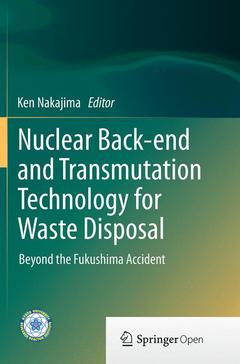Nuclear Back-end and Transmutation Technology for Waste Disposal, 2015 Beyond the Fukushima Accident
Coordonnateur : Nakajima Ken

This book covers essential aspects of transmutation technologies, highlighting especially the advances in Japan. The accident at the Fukushima Daiichi Nuclear Power Plant (NPP) has caused us to focus attention on a large amount of spent nuclear fuels stored in NPPs. In addition, public anxiety regarding the treatment and disposal of high-level radioactive wastes that require long-term control is growing. The Japanese policy on the back-end of the nuclear fuel cycle is still unpredictable in the aftermath of the accident. Therefore, research and development for enhancing the safety of various processes involved in nuclear energy production are being actively pursued worldwide. In particular, nuclear transmutation technology has been drawing significant attention after the accident.
This publication is timely with the following highlights: 1) Development of accelerator-driven systems (ADSs), which is a brand-new reactor concept for transmutation of highly radioactive wastes; 2) Nuclear reactor systems from the point of view of the nuclear fuel cycle. How to reduce nuclear wastes or how to treat them including the debris from TEPCO?s Fukushima nuclear power stations is discussed; and 3) Environmental radioactivity, radioactive waste treatment and geological disposal policy.
State-of-the-art technologies for overall back-end issues of the nuclear fuel cycle as well as the technologies of transmutation are presented here. The chapter authors are actively involved in the development of ADSs and transmutation-related technologies. The future of the back-end issues in Japan is very uncertain after the accident at the Fukushima Daiichi NPP and this book provides an opportunity for readers to consider the future direction of those issues.
1 Nuclear Transmutation of Long-Lived Nuclides with Laser Compton Scattering: Quantitative Analysis by Theoretical Approach.- 2 Recent Progress in Research and Development in Neutron Resonance Densitometry (NRD) for Quantification of Nuclear Materials in Particle-Like Debris.- 3 Development of Nondestructive Assay to Fuel Debrisof Fukushima Daiichi NPP (1): Experimental Validation for the Application of a Self-Indication Method.- 4 Development of Nondestructive Assay of Fuel Debris of Fukushima Daiichi NPP (2): Numerical Validation for the Application of a Self-Indication Method.- 5 Precise Measurements of Neutron Capture Cross Sections for LLFPs and Mas.- 6 Development of the Method to Assay Barely Measurable Elements in Spent Nuclear Fuel and Application to BWR 99 Fuel.- 7 Contribution of the European Commission to a European Strategy for HLW Management Through Partitioning & Transmutation: Presentation of MYRRHA and Its Role in the European P&T Strategy.- 8 Design of J-PARC Transmutation Experimental Facility.- 9 Accelerator-Driven System (ADS) Study in Kyoto University.- 10 Heat Transfer Study for ADS Solid Target: Surface Wettability and Its Effect on a Boiling Heat Transfer.- 11 Experimental Study of Flow Structure and Turbulent Characteristics in Lead–Bismuth Two-Phase Flow.- 12 Theory of Power Spectral Density and Feynman-Alpha Method in Accelerator-Driven System and Their Higher-Order Mode Effects.- 13 Study on Neutron Spectrum of Pulsed Neutron Reactor.- 14 Application of the Resource-Renewable Boiling Water Reactor for TRU Management and Long-Term Energy Supply.- 15 Development of Uranium-Free TRU Metallic Fuel Fast Reactor Core.- 16 Enhancement of Transmutation of Minor Actinides by Hydride Target.- 17 Method Development for Calculating Minor Actinide Transmutation in a Fast Reactor.- 18 Overview of European Experience with Thorium Fuels.- 19 Transmutation Scenarios after Closing Nuclear Power Plants.- 20 Sensitivity Analyses of Initial Compositions and Cross Sections for Activation Products of In-Core Structure Materials.- 21 Options of Principles of Fuel Debris Criticality Control in Fukushima Daiichi Reactors.- 22 Modification of the STACY Critical Facility for Experimental Study on Fuel Debris Criticality Control.- 23 Expectation for Nuclear Transmutation.- 24 Issues of HLW Disposal in Japan.- 25 Considering the Geological Disposal Program of High-Level Radioactive Waste Through Classroom Debate.- 26 Environmental Transfer of Carbon-14 in Japanese Paddy Fields.- 27 Development of a Rapid Analytical Method for 129I in the Contaminated Water and Tree Samples at the Fukushima Daiichi Nuclear Power Station.- 28 Consideration of Treatment and Disposal of Secondary Wastes Generated from Treatment of Contaminated Water.- 29 Volume Reduction of Municipal Solid Wastes Contaminated with Radioactive Cesium by Ferrocyanide Coprecipitation Technique.
Presents state-of-the-art technologies to resolve nuclear back-end issues
Includes policies for the nuclear fuel cycle after the Fukushima accident
Proposes a variety of nuclear reactor systems for future development
Includes supplementary material: sn.pub/extras
Date de parution : 09-2016
Ouvrage de 341 p.
15.5x23.5 cm
Date de parution : 11-2014
Ouvrage de 341 p.
15.5x23.5 cm



